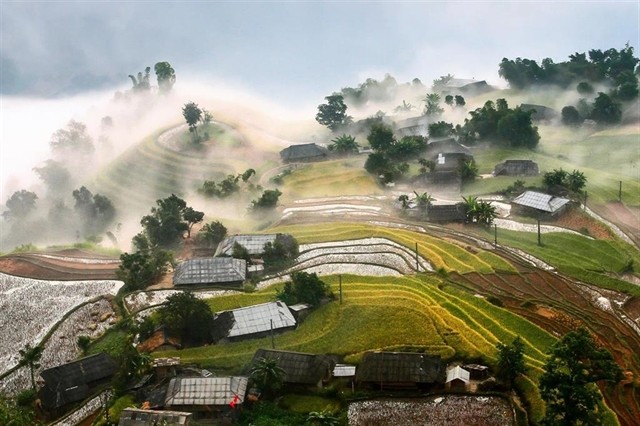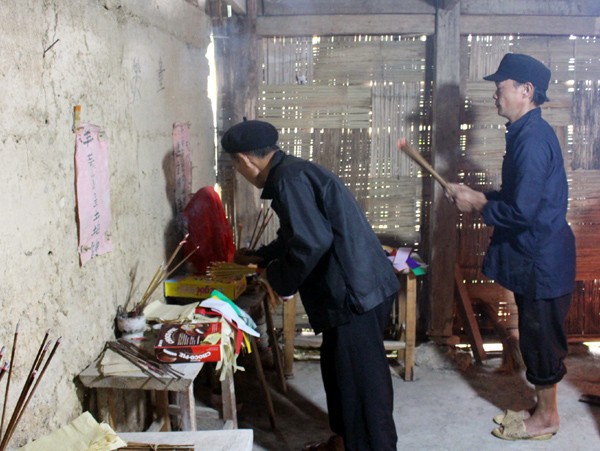
Ha Giang's spiritual ceremonies get national recognition
Latest
 |
| Located in the west of the northernmost mountain province of Ha Giang, Hoang Su Phi is famous among tourists for its charming landscapes. (Photo: didulich.net) |
They are the post-harvest festival of the Red Co Lao ethnic group and the Ban Vuong worship ceremony of the Red Dao in Tung San and Ho Thau communes, respectively.
Located in west Ha Giang, Hoang Su Phi is famous not only for its charming landscapes but also for its 13 ethnic groups, including the Dao, Tay, Nung, Mong, Co Lao, and La Chi.
The district is also one of the localities suffering special difficulties due to harsh natural conditions.
Fortunately, harsh living conditions and geographical factors have not hindered people from retaining many unique aspects of their longstanding traditional culture.
With maize and rice their major crops, the Co Lao honour agriculture, and every year organise a post-harvest festival, which is central to their beliefs.
Families prepare boiled chicken and pork, sticky rice, white wine, fruit, gold coins and incense as offerings for the ceremony.
A shaman is invited to carry out basic rituals to thank the gods, heaven, earth and ancestors for bountiful crops.
Then Ngoc Minh, chairman of the Hoang Su Phi People's Committee, said the post-harvest festival reflected the typical agricultural beliefs of the Co Lao.
"Every year, after harvesting rice and corn, the Co Lao people hold the ceremony to express gratitude to the gods and ancestors for blessing them with good weather and bountiful crops," he said.
They also pray for a new bumper harvest for the next crop with favourable weather conditions, happiness, and prosperity.
Apart from such rituals, the ceremony also features festivities such as folk singing and games.
 |
| Local Co Lao ethnic men worship at the post-harvest ceremony in Hoang Su Phi District. (Photo: baohagiang.vn) |
The Co Lao, one of Viet Nam's 54 ethnic groups, has a population of about 3,000. The group settled in the country about 200 years ago and live mainly in the northern mountainous region. They have other branches such as the Green Co Lao, Red Co Lao, and White Co Lao in Hoang Su Phi and Đong Van districts in Ha Giang.
Growing rice on terraced fields and maize, buckwheat, green peas, and roots is the main farming work of the Co Lao.
Nguyen Huu Son, vice chairman of the Viet Nam Folklore Association, said: "Life in Co Lao has improved a lot. In the past, they wove fabric and used natural dyes. Now they buy cloth to make their clothes, but their costumes keep the original decoration and design."
A Co Lao village has 15 to 20 households of the same clan. They make earthen-walled houses with long grass roofs. The Co Lao worship ancestors going back three or four generations.
Farming on rocky, sloping fields is extremely hard. So, men are the pride of the family.
Luu Sam Van, a researcher of ethnic culture, said: "The coming of age ceremony of the Co Lao recognises an adult man's new role in the family and community. He can now lead his family and join community activities."
Meanwhile, the Ban Vuong worship ceremony is how the Red Dao in Ho Thau Commune express their gratitude towards Ban Vuong, the legendary ancestor of the 12 Dao clans.
"The Ban Vuong worship ceremony shows the Red Dao people's respect for their ancestors and the aspiration for a peaceful life, good weather and bumper crops," Minh said.
The worship of Ban Vuong is related to the destiny of each person, each clan, and the entire ethnic group.
Taking place between the 15th day of the 10th lunar month and the 30th day of the last lunar month, the event is also a ceremony to pray for communal prosperity.
Three shamans usually conduct the ceremony: the first one, the chief shaman, worships the return of two "divine pigs" to Ban Vuong and his ancestors.
The second shaman prays to the gods for health, good rice crops and livestock.
The third brings offerings to the gods and ancestors.
 |
| A shaman performs the Ban Vuong worship ritual. (Photo: VNA) |
On an auspicious day at the selected hour, the three shamans invite the family to set up an altar for Ban Vuong worship. First, they hung two sets of Tam Thanh paintings next to the ancestral altar. Only those who work as shamans have such painting sets.
They perform cleansing works by sprinkling "magical water" all over the house and sticking magic papers with words written in the Nôm ideographic script around the house, then invite Ban Vuong, the ancestors and gods to attend the ceremony.
On the altar display, offerings include a slaughtered pig (called the god-pig), a rooster, a traditional sticky rice cake, a bag of rice wrapped in white cloth, offering paper and seven other objects for the shamans to perform the worship.
Previously, the worship ceremony usually took place over three days and three nights. Today, it is shortened but still retains its sacredness.
Ha Giang now has 27 items of national intangible cultural heritage. Their numerous customs, traditions, cultures and lively festivals have helped the province become an attractive destination for tourists.

















